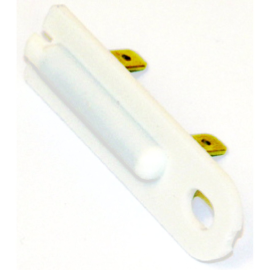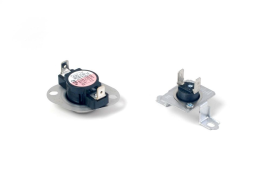Dryer common questions


These common questions about dryers are the ones our experts hear the most often from our customers. You might also find the help you need by checking the common symptoms and solutions for dryers. When you’re ready to make a repair, search your model number to find replacement parts. Sears PartsDirect has the part you need, no matter where you bought your dryer.
Why does my gas dryer heat up when the cycle starts and then stop heating?
A gas dryer that heats up when you start it but then stops heating could have a clog or other restriction in the exhaust air duct system. The exhaust air stays near the operating thermostat or thermistor, keeping the dryer from heating properly. Check the flexible vent behind the dryer for a kink or a lint clog. Check for lint buildup in the air ducts running to the outside your home. Make sure the damper on the exit vent outside your home opens easily.
If the exhaust air path is clear, you might need to replace the gas valve coils, following the steps in the gas valve coil repair guide. Weak gas valve coils operate properly from a cold start but fail to open the gas valve during subsequent ignition attempts.
Why does my dryer shut off after about 15 minutes in the auto dry cycle?
Check the moisture sensor bars for a buildup of fabric softener residue that can keep them from sensing moisture in the clothes. Remove any residue with rubbing alcohol.
A disconnected or broken wire on the sensor bars can also cause this problem.
Why won’t my electric dryer heat?
Check the house circuit breakers for the dryer. The dryer can run on 120 volts but won’t heat if the 240-volt power supply is off.
If the breakers are switched on, unplug the dryer and check the outlet cord. A damaged outlet cord or faulty connection on the terminal block at the back of the dryer might be the problem.
A broken heating element, a damaged operating thermostat, a blown thermal cut-off fuse, a failed high-limit thermostat, or a bad motor switch can also impair heating. Once you find the cause of your failure, use the appropriate dryer repair guide to replace the defective component.
Why do my clothes take so long to dry?
Inadequate air flow through the dryer usually causes clothes to take a longer time to dry.
Check the lint screen to make sure that it’s clean; you should clean the lint screen before every dryer load.
Dryer softener sheets can cause residue to build up on the screen. That residue is difficult to see. Wash the lint screen with water and a soft-bristle brush monthly if you use dryer softener sheets.
Check the exhaust vent duct path to the outside of your home, starting with the flexible vent hose behind the dryer. Make sure the flexible vent isn’t kinked or clogged. Check the duct system going to the outside of your home and clean the duct system if necessary. Make sure the damper for the duct system on the outside of your home opens properly.
How do I convert my liquid propane dryer back to natural gas?
Hopefully you saved the natural gas orifice originally installed in your gas dryer. If not, order the natural gas orifice and any other natural gas parts that were removed to convert the dryer to liquid propane (LP) gas. Refer to the LP Conversion Kit Instructions for your dryer to determine the parts that you need. A qualified installer should complete the natural gas conversion to ensure that the dryer is safe to use.
Why is my dryer squeaking?
Some models of dryer have a ball-and-hitch bearing on the back of the dryer drum that supports the drum as it rotates. Check the parts diagram for your dryer to see if your dryer drum is supported by a ball-and-hitch system. If so, unplug the dryer and lift the top panel of the dryer. Manually spin the drum to determine if the ball-and-hitch bearing is squeaking. If the bearing is making the noise, buy and install the bearing kit to replace the worn bearing.
A metallic rubbing type of squeak is caused by worn out drum glides. Unplug the dryer, open the back of the cabinet and check the drum glides. If the drum glides are worn out, replace them.
Why are my clothes slightly damp when I use the automatic cycle?
Most automatic drying systems intentionally leave the clothes very slightly damp to prevent shrinking, wrinkles and damage to garments. Some dryers allow you to adjust the dryness setting in the automatic cycle to dry the clothes completely. Check your owner’s manual for instructions if your dryer has that feature. If not, then you can tumble the clothes for a few minutes longer using a timed cycle to finishing drying the load.
If the clothes are very damp instead of slightly damp, then the moisture sensing system is malfunctioning. The moisture sensing system will need to be examined and repaired (usually by a technician).
Why does the dryer drum turn blue?
Bluing of the dryer drum is caused by dye transfer from clothing, typically from blue jeans or similar garments. The heat inside the drum and the tumbling cause the blue dye to rub off on the inside of the drum. This dye transfer is normal. The dye on the drum doesn’t transfer to garments during subsequent cycles.
If the bluing is caused by an exploded ink pen, remove the ink using soft scrub cleansers. If the ink cannot be cleaned out, then the drum and other dryer components will need to be replaced.
Why can’t I see steam inside my steam dryer?
You can’t see the steam in a stem dryer because of how the steaming process works: the steam system emits a fine mist that vaporizes inside the dryer drum.
On some models, you can see condensation on the dryer door during certain steam cycles.
A service technician will usually need to examine the dryer and repair the steam system if it’s not working.
Why does my Evenheat dryer shut off when I release the start button?
A dryer with the Evenheat features uses an electrical relay to keep the dryer motor running after you push the Start button. The problem isn’t the Start button—a defective motor relay or defective Evenheat electronic control board is preventing the dryer from continuing to run. Replace the motor relay to fix this problem since it’s less expensive than the Evenheat control board. If the problem persists, then replace the Evenheat control board. Unplug the dryer before accessing and replacing internal components.
Most common symptoms to help you fix your dryers
Choose a symptom to see related dryer repairs.
Main causes: bad gas valve coils, broken heating element, tripped safety thermostat or fuse, bad operating thermostat, c…
Main causes: bad timer or electronic control board, door switch failure…
Main causes: lack of electrical power, bad power cord, wiring failure, bad control board, blown thermal fuse, bad door s…
Main causes: clogged exhaust vent, bad motor relay, loose dryer door catch, bad door switch, control system failure, fau…
Main causes: damaged door strike, worn door catch…
Main causes: bad drum support roller, damaged idler pulley, broken blower fan blade, worn drum glide bearing, bad drive …
Main causes: clogged exhaust system, heating system failure, deposits on moisture sensor, control system failure…
Main causes: door switch failure, lack of power, broken belt, blown thermal fuse, bad drive motor, control system failur…
Most common repair guides to help fix your dryers
These step-by-step repair guides will help you safely fix what’s broken on your dryer.

How to replace a thermal fuse in an electric dryer
When the air in the dryer overheats—usually because the vent is clogged—the thermal fuse blows, stopping the dryer. You …

How to install a thermal cut-off fuse kit in an electric dryer
The thermal cut-off fuse shuts off the heat if the dryer overheats when the high-limit thermostat fails. Install a ther…

How to replace a dryer door switch
The dryer won't start if the door switch isn't working correctly. You can install a replacement dryer door switch in les…
Effective articles & videos to help repair your dryers
Use the advice and tips in these articles and videos to get the most out of your dryer.

Get expert tips on using your dryer efficiently to save energy.…

Learn about all the convenient features on our Sears PartsDirect website that make your parts purchases easier.…

Get answers to frequently asked questions about Sears and Sears PartsDirect.…
